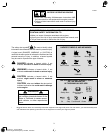
Document: - page 5 (Black)
Screen angle and frequency: 45.0000, 150.0000
5
SAFETY
Engines give off carbon monoxide, an
odorless, colorless, poison gas.
Breathing carbon monoxide can cause
nausea, fainting or death.
WARNING
• Start and run engine outdoors.
• Do not start or run engine in enclosed area, even if
doors or windows are open.
WARNING
Running engines produce heat. Engine
parts, especially muffler, become extremely
hot.
Severe thermal burns can occur on contact.
Combustible debris, such as leaves, grass,
brush, etc. can catch fire.
• Allow muffler, engine cylinder and fins to cool
before touching.
• Remove accumulated combustibles from muffler
area and cylinder area.
• Install and maintain in working order a spark
arrester before using equipment on forest-covered,
grass-covered, brush-covered unimproved land.
The state of California requires this (Section 4442
of the California Public Resources Code). Other
states may have similar laws. Federal laws apply
on federal land.
WARNING
Unintentional sparking can result in fire or
electric shock.
Unintentional start-up can result in en-
tanglement, traumatic amputation, or lac-
eration.
BEFORE PERFORMING ADJUSTMENTS OR
REPAIRS
• Disconnect spark plug wire and keep it away from
spark plug.
• Disconnect battery at negative terminal (only
engines with electric start).
WHEN TESTING FOR SPARK
• Use approved spark plug tester.
• Do not check for spark with spark plug removed.
ENGINE INFORMATION
TECHNICAL INFORMATION
POWER RATINGS: The power ratings for an individual engine
model are initially developed by starting with SAE (Society of
Automotive Engineers) code J1940 (Small Engine Power &
Torque Rating Procedure) (Revision 2002-05). Given both the
wide array of products on which our engines are placed, and the
variety of environmental issues applicable to operating the
equipment, it may be that the engine you have purchased will not
develop the rated horsepower when used in a piece of power
equipment (actual “on-site” power). This difference is due to a
variety of factors including, but not limited to, the following:
differences in altitude, temperature, barometric pressure,
humidity, fuel, engine lubrication, maximum governed engine
speed, individual engine to engine variability, design of the
particular piece of power equipment, the manner in which the
engine is operated, engine run-in to reduce friction and clean out
of combustion chambers, adjustments to the valves and
carburetor, and other factors. The power ratings may also be
adjusted based on comparisons to other similar engines utilized
in similar applications, and will therefore not necessarily match the
values derived using the foregoing codes.


















